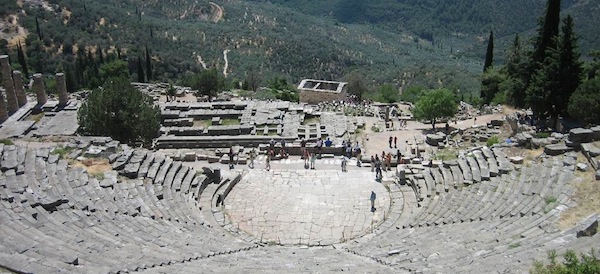
The ancient theatre of Delphi is one of few for which chronological dates are known.
The date of construction, design and shape of its “koilon” or cavea are all recorded, as are changes made to the theatre’s original structure in the following years.
The first theatre was erected in the 4th century BC and took on its current form during the first years of the Roman period. It was restored for the first time in 159 BC by King Eumenes II of Pergamon.
In the original theatre, the public is likely to have been seated on wooden seats or on the floor. The building lies within the complex of the sanctuary of Apollo and was the biggest building of the entire site, with a total capacity of 5,000 spectators.
In ancient times, the theatre hosted phonetic and instrumental music competitions, which were held as part of the Pythian Games, the most important in Ancient Greece after the Olympics.
The Games would take place once a year, with the winners receiving a crown of laurels from the bay tree sacred to the God Apollo, which was situated in the Vale of Tempe.
Later on, towards the middle of the third century BC, the Games were turned into a national competition to be held every four years.
The preliminary study for the restoration of the theatre, which has been approved by the National Archaeological Council, is based on research carried out by the French School of Architecture, which has been present in the area since the previuos century.
The aim of the study is to restore the structure of the cavea and the surviving white stand, made of white marble from Mount Parnassus, which dominates the Delphic site. The Roman theatre of Nicopolis, one of the largest of the period, with a capacity of 15,000 spectators, is six kilometres from Preveza, a small town in the Epirus area.
The theatre was build in the Proasteion area north of the town by Octavian Augustus to commemorate the victory over Mark Antony and Cleopatra in the naval battle of Actium in 31 BC. The theatre was used mainly for the Actian Games, a series of religious games staged in honour of Apollo, featuring poets, philosophers, comedians, preachers and mime artists.
The Emperor Nero also took part in the games, having visited Nicopolis twice, and renamed the city Neronicopolis. The plan to restore the theatre, which has been drawn up by the Institute of Archaeological Studies of Epirus, includes the urgent repair of walls on which many deep cracks are apparent.
See all the latest news from Greece and the world at Greekreporter.com. Contact our newsroom to report an update or send your story, photos and videos. Follow GR on Google News and subscribe here to our daily email!



